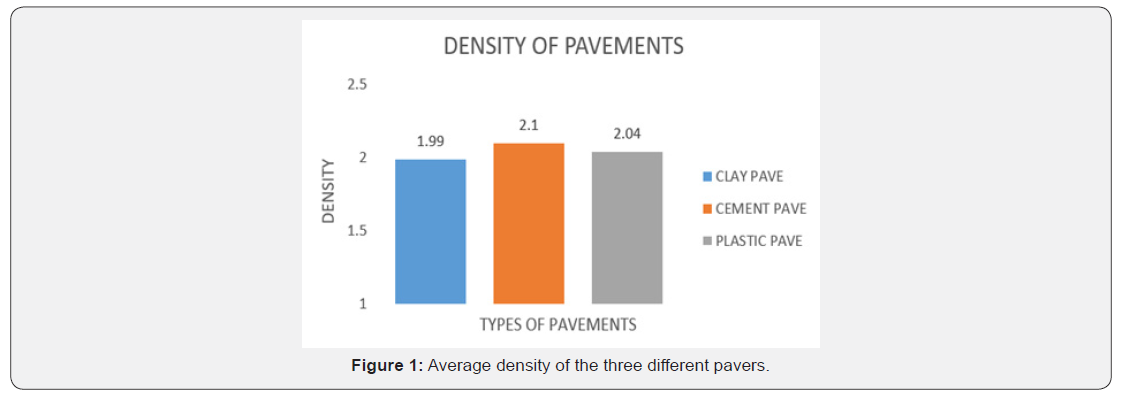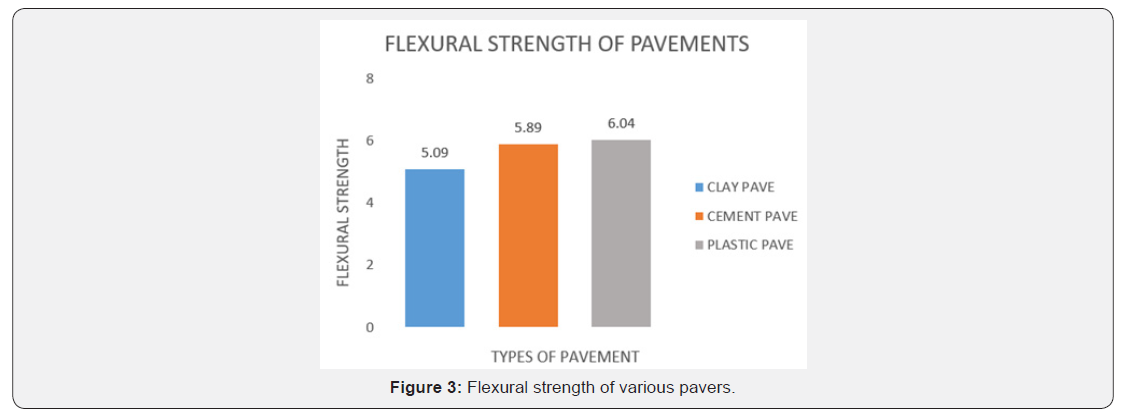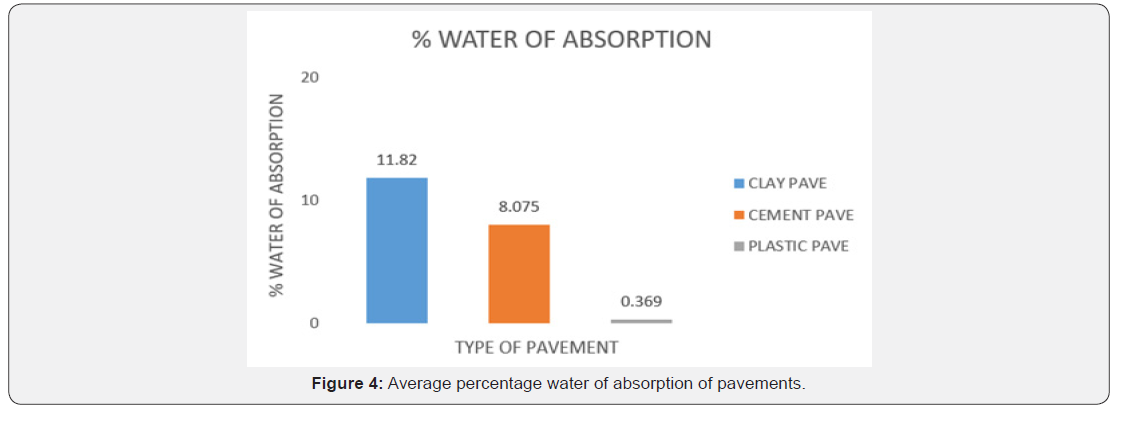Civil Engineering Research Journal
Abstract
Many developing countries are facing a lot of
challenges with management of huge quantities of solid waste generated
on daily basis. Plastic waste which is part of solid waste poses a
menace to sustainable development due to its slow rate of degradability
and the indiscriminate way it is disposed. To lessen the negative
impacts on the environment and the associated effects on human health,
plastic waste is being considered as materials in transition and are
being used in the production of pavement blocks and other materials for
construction purposes. The study reports some physical and mechanical
properties of plastic waste pavement blocks produced by one company in
Ghana which has taken a major lead in the direction of adding value to
plastic waste for construction. Results are compared to two other
pavement block types made from cement and fired clay pavement blocks and
discussed. Using plastic waste as transition materials for pavement
blocks may among other benefits listed, translate to reduction in
construction cost and large quantities of plastic waste polluting the
environment and may contribute to cleaner cities and towns.
Keywords: Plastic waste; Transition materials; Pavement blocks; Environment; Construction
Introduction
Economic growth and changing consumption patterns are
resulting in rapid increase in the use of plastics in the world. Thus,
consumption of plastic material has increased from 5 million tons in the
1950s to 100 million in the 2000s. In Ghana per capita generation of
plastic waste has been reported to be between 0.0016-
0.035kg/person/day. And, plastics make up between 18-20% component
materials in the waste stream [1]. There are however concerns about
plastic waste disposal methods commonly employed in many developing
countries as they do not deal effectively with the large tonnes of
plastic waste generated. These disposal methods include dumping plastic
waste in landfills, incineration and open littering. Since plastics take
several years to degrade, there are challenges associated with their
improper disposal which include:
i. Blocking drains and choking of gutters which may contribute to floods
ii. Release of toxic gases into the atmosphere when
openly burnt. Some of these gases may be harmful to humans and cause
greenhouse effects.
iii. Discarded bottles and containers may serve as breeding grounds for mosquitoes when filled with rainwater.
iv. Washing of the littered plastic materials into water bodies including oceans contributing to decline of ocean life.
Common pavement materials used in Ghana include the
cement pavement blocks and the fired clay pavement bricks. Portland
cement imported into the country is used in the production of cement
pavement blocks and is associated with increasingly high cost due the
unstable value of foreign exchange. Fired claypavers produced from
available local clay materials are not very popular with a lot of people
because they are perceived by many as expensive. The production of
fired clay pavers currently in the country relies on firewood burnt at
very high temperatures. This firing method is not sustainable and
associated with consumption of a lot energy. In recent times, due to the
ecological and environmental challenges associated with the disposal of
plastic waste, there are a lot of interest in turning plastic waste
into a resource in construction. Pavement blocks produced from waste
plastic and other materials like sand, quarry dust etc., is recently
being promoted in many developing countries as a more affordable and a
sustainable material which may be used in construction and Ghana is no
exception. Though it is generally known that these plastic waste
pavement blocks are strong and durable, there is little scientific data
in Ghana to support this claim. This paper therefore reports a study on
three types of pavement blocks produced from plastic waste, fired clay,
and cement with regards to some of
their physical and mechanical properties.
Materials and Methods
Materials
The pavements samples under study were obtained from
three different commercial paving factories in Ghana. The raw
materials used in the production of these pavers comprised of
cement, quarry dust and fine aggregates (sand), for the cement
pavers, clay for the clay pavers, and waste plastics and sand for
the plastic pavers. Six samples of each paver types were randomly
selected and tested for each of the various physical and mechanical
properties which include density, compressive strength, flexural
strength, abrasive resistance, water of absorption and durability
in sea water. Plastic pavement blocks were commercially
produced in bigger sizes of 30cm by 30cm. They were cut into 4
equal part with half remaining. And test run on samples of dimension
20cm by 10cm with a thickness of 5cm. This is to make sure
all types of pavement blocks have comparable sizes. Cement and
fired clay pavement blocks are of hexagonal shape and with dimensions
23cm by 14cm with thickness 5m and 20m by 10.5 with
thickness 6.5cm respectively. The samples were cured for more
than 28 days to ensure maximum mechanical strength development
before the various test were conducted.
Method
Antifungal resistance
Density: The density of the various paving bricks was
determined using Archimedes principle of water displacement.
Dry weights of various pavers were measured and fully immersed
in a tank containing water. The volume of water displaced was
measured for each pavement type, and the average volume of
water displaced was recorded for five samples each of the various
pavers. The densities of the various pavers were determined by
dividing the dry weight by the volume of water displaced [2].
Compressive strength: The compressive strength is the
most prioritized property to be achieved in the production of
paving bricks in almost every factory that is actively involved
in manufacturing of pavers [3]. Hydraulic universal testing
machine which has a maximum capacity up to 2500KN was
used to determine the compressive of the various pavers in this
study. The load was applied to the nominal area of the cement,
clay and rubberized pavers to determine the various compressive
strengths. The corrected compressive strength was computed
using correcting factors (BIS, 2006).
Flexural strength: Flexural strength is one of the tests
performed on paver blocks which serves as a quality indicator
and it is considered as a basis for comparison in terms of wearing
resistance. Flexural strength test was performed by subjecting the
various pavers to a thwartwise force which is perpendicular to its
longitudinal axis. A center line was indicated on top of the pavers
which is perpendicular to its length. The pavers were supported
by two support rods over a span of 150mm and were tested under
a central line load until failure occurred, using the INSTRON
universal testing machine. The flexural strength values recorded
are the average of five samples each for the various paver [4].
Water of absorption and durability in sea water: Water
of absorption is the determination of the rate of absorption
by measuring the increase in mass of the pavers resulting
from absorption of water over a period. The pavers were fully
immersed in a tank of fresh water for 24 hours and the weight
measured to determine the percentage of water absorption. And,
the pavements were fully immersed in a tank of sea water for four
months to determine its durability by applying a load to determine
the compressive strength using the universal testing machine. The
percent water of absorption is determined using equation (1),

Results
Density
The density values of the various pavers are presented in Figure
1. The values range between 1.99g/cm3 to 2.04 g/cm3, with
fired clay pavement block having the lowest and cement pavement
block having the highest.

Compressive Strength
As shown in Figure 2 above, clay brick pavement blocks recorded
the highest compressive strength followed by the plastic
pavement blocks with the cement pavement blocks recording the
least compressive strength.

Flexural Strength
Figure 3 shows the test results of flexural strength of plastic
paver, cement paver and clay bricks to be 6.04MPa, 5.86MPa and
5.09MPa respectively.
Water of Absorption
Figure 4 shows the percentage water of absorption test results
for clay bricks, cement blocks and plastic pavers as 11.82,
8.075 and 0.369 respectively


Abrasion Resistance
Abrasive resistance is a measure of the resistance of paving
brick to the wearing action due to traffic and can be calculated
using equation (2).

The maximum abrasion index for Type III i.e. pedestrian and
light traffic pavement is 0.50 and the minimum abrasion limit for
a 28day cured concrete paver is 1.20 for footpaths and car parks
(ASTM C 902-15). The three types of pavers have abrasion index
of 0.35, 0.14 and 0.014 for clay, cement and fired clay pavement
blocks respectively Figure 5.

Durability in Sea water
Percentage of seawater absorbed by the three different pavement
blocks are shown in Figure 6 above.
Discussion
The density of burnt brick pavers has been stated to be between
1.826g/cm3 and 1.985g/cm3, and specific gravity of special
masonry varies between 1.20g/cm3 and 2.40g/cm3(ASTM C-902).
From the results in Figure 1, Clay pavers had the minimum density
value followed by the plastic and cement pavers of densities 2.04g/
cm3 and 2.10g/cm3 respectively. The 3 types however fall within
the standard specification. Clay pavement blocks recorded higher
average compressive strength, followed by plastic pavement
blocks and then cement pavement blocks. Clay pavement blocks
have highest thickness compared to plastic and cement pavement
blocks and this may have contributed to the high compressive
strength. Also, the compressive strength of the plastic pavement
blocks was not determined on full blocks but on a cut-out section,
may have caused a reduction in the compressive strength of
plastic pavement blocks as noted by Vila et al. [5]. The production
of clay bricks currently in Ghana relies on firewood and requires
much energy during firing. Harmful gases such CO2 may also be released
into the environment which is not eco-friendly. When firing
is not well controlled, clay bricks can develop cracks which may
lead to reduction in strength.
Cement pavers recorded the least compressive strength value
as compared to the rubberized pavers. Poor compaction is a major
factor that influence the strength of cement pavers which creates
more pores to absorb water. Secondly, decreased strength in concrete
pavers can be attributed to variation in the mix proportions
in the batching process. Improper mixing proportions and insufficient
compaction hinders the achievement of maximum density
and creates voids which contributes to reducing the strength
of the concrete pavers. Increasing void content and decreasing
density decreases the compressive of the concrete pavers [6].
Plastic pavers recorded higher compressive value than cement
pavers. Melting of plastics for plastic pavers requires less energy
since plastics have low melting points and melting is done at low
temperatures. The melting process does not release harmful gases
into the environment, and it is cheaper to produce. Therefore,
plastic pavers may be used commercially for non-traffic application.
The high flexural strength average value obtained for plastic
modified pavement block as compared to the concrete pavers
and clay bricks may be due to good adhesion of molten plastic to
the sand particles and low porosity. This is an indication that the
plastic pavement blocks could withstand higher flexural stresses
than the rest
Results obtained for water of absorption indicated that clay
brick absorbed maximum water as compared to cement paver and
plastic paver. The maximum water absorption by the clay bricks
may have occurred as a result of the presence of pores and due
to the hydrophilic nature of clay. Increased absorption of water
may result in loss of bondage of clay particles hence reduced
strength of clay pavement blocks in service. The cement pavers
absorbed less water as compared to the clay bricks. This is because
the cement creates stronger bonds between the particles,
and this minimizes the pores through which water get absorbed
by the concrete pavement block [7]. However average value obtained
for both fired clay and cement pavement blocks are more
than the minimum value of 5%. Thus, the use of these pavement blocks may not be durable especially in waterlogged areas. Water
absorption values obtained for plastic pavers are within the
specified standard of less than 5%. This may be due the low porosity
of the rubberized paver and due to the hydrophobic nature
of plastics. The water of absorption of plastic pavers have been
found to further decrease when the proportion of plastic waste is
increased. The low porosity of the plastic pavers may contribute
to little or no damage under severe conditions such as heavy rains
as compared to clay bricks and cement pavers. Clay bricks and cement
pavers may absorb water under severe condition, and this
has a tendency of weakening the bonds that exist between their
structures which may lead to formation of micro cracks. Hence
any load applied on clay bricks and cement pavers, may act on
the stress concentration points because of the presence of micro
cracks and this may cause decrease in strength. The very low
abrasion resistance value recorded by the plastic pavers indicates
that plastic pavers have high ability to withstand wearing action
than clay bricks and cement pavers which may be as a result of the
good adherence of the plastic with the sand aggregates. Seawater
durability is the ability of pavers to resist permeability of saline
solution and have improved strength to be serviceable. Four
months durability in Sea water test results are shown in Figure 4
for the various types of pavers under study.
The permeability of sea water in pavers causes two main
actions to occur; chemical reaction which usually occurs within
the pavers resulting in softening and disruptive expansion of the
pavement blocks, and crystallization of salts which occurs on the
surface of the pavers. As pavers absorb sea water, the dissolved
salts in the form of crystals are left within the joint and the pores
of the pavers which may cause expansion and increases porosity
thereby reducing the strength of pavers [8]. As indicated by
results in Figure 6, plastic pavers absorbed less Sea water. This
may be due to the low porosity exhibited and due to the structure
of plastics, i.e. strong with close intermolecular links and so this
type of pavers resists sea water [9-14] absorption as compared to
the cement and clay pavers. Therefore, plastic pavers may remain
stronger in terms of durability in high saline environment.

Conclusion
In this study clay pavement and plastic pavement blocks
obtained higher average compressive strength than the cement
pavement blocks. Durability studies suggested that plastic
pavement blocks may perform better in areas prone to flooding
and high saline content. Though the various pavement blocks
may be used for footpath, light traffic, walkway etc., the plastic
pavement blocks made from waste plastic and sand may be cheaper
and represent an alternative way of turning waste material into
useful product for a more sustained construction. Plastic waste
use as transitional material in construction is a demonstration
of how waste could be turned into a resource for cost effective,
yet a durable and sustainable material for construction. Other
advantages include minimizing plastic waste in the environment,
the landfills and water bodies contributing to cleaner cities and
towns and creation of more jobs.
To Know More About Civil Engineering Research Journal Please click on:





Very nice blog information.. Great post.
ReplyDeleteWhether you require repairs for your potholes or advice on achieving better drainage on your driveway, our staff can help improve the safety and value of your property.
Construction Companies Winnipeg
Concrete Paver Winnipeg